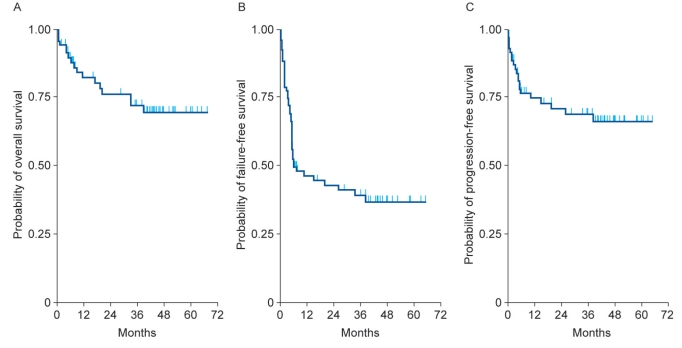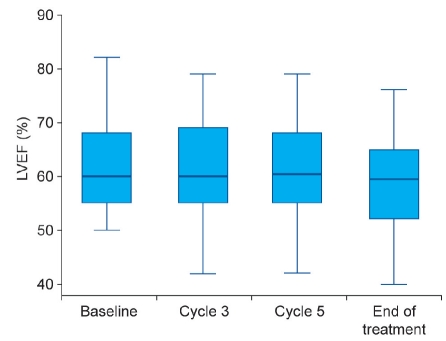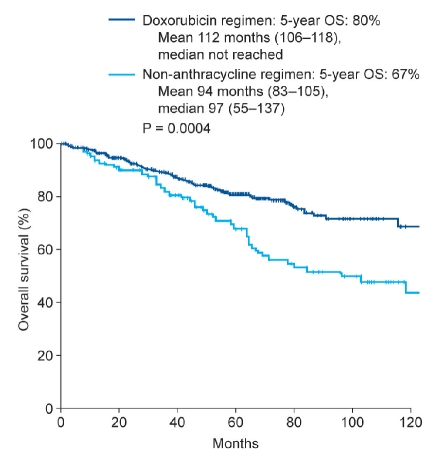Abstract
Since anthracyclines were introduced in the treatment of non-Hodgkin's lymphoma in the late 1960s, they have been acknowledged as a cornerstone in the management of the disease and, in particular, of aggressive lymphomas. The high efficacy of anthracycline-containing regimens must, however, be balanced against the drug-related toxicity, which mainly affects the cardiovascular system and represents a major concern for clinicians, especially in the treatment of elderly patients. Patients' outcomes could be further improved, particularly for those at high risk of cardiotoxicity, by substituting liposomal doxorubicin for conventional doxorubicin. This approach has already been tested and shown to be effective in several cancers, especially in different subsets of patients with diffuse large B-cell lymphoma. The use of liposomal doxorubicin in combination regimens for other conditions, such as follicular lymphoma and splenic marginal zone lymphoma, is also under investigation, and early results are promising.
Key words: non-Hodgkin's lymphoma, treatment, anthracycline.
Challenges in treating lymphoma
Non-Hodgkin's lymphoma (NHL) is the most common cancer of the lymphatic system and represents the fifth most frequent cancer in Western countries. Recent estimates of lymphoma incidence in Italy predict that there will be nearly 15,000 new cases of NHL in 2011. Diffuse large B-cell lymphoma (DLBCL) is the most common aggressive lymphoma, representing more than 40% of new cases. Most importantly, more than half of all patients with NHL and DLBCL are older than 60 years.1–3
History of anthracycline use in NHL
The history of treatment of aggressive NHL started more than 50 years ago, with the use of alkylators as single agents, with disappointing results. In 1969, the first antitumor antibiotic – doxorubicin – became available and, over time, clinical trials demonstrated that this was the most effective single agent for the treatment of NHL. Subsequently, the combination treatment of cyclophosphamide, hydroxydaunorubicin (doxorubicin), vincristine, and prednisone (CHOP) was found to be a highly effective treatment for aggressive NHL and became the gold standard.4 In addition, reduction of the inter-treatment interval,5 and the addition of rituximab to CHOP (R-CHOP)6–8 were both found to improve patient outcomes.
At present, the R-CHOP combination given every 3 weeks is the standard treatment for DLBCL in elderly patients and is associated with a 5-year overall survival rate of about 60%.7 The transferability of R-CHOP from clinical trials to practical management of elderly patients with DLBCL is, however, still an issue. The R-CHOP regimen is often poorly tolerated in elderly patients, which necessitates dose reductions that may result in a lower response and cure rate compared with younger patients.9 Moreover, treatment-related mortality for this therapy is close to 6%, and cardiologic toxicity induced by doxorubicin remains a concern for clinicians.10–12 Different strategies have been adopted in an attempt to reduce anthracycline-induced toxicity. These include the design of combination regimens with reduced drug doses,9,13–15 a maintained anthracycline dose but with the addition of cardioprotectants,16,17 or the use of liposome-encapsulated anthracyclines.18,19
Non-pegylated liposomal doxorubicin (NPLD) has a shorter circulation time than its pegylated counterpart.20 Animal data showed that NPLD reduced drug delivery to the myocardium and increased delivery to the liver, spleen, and bone marrow.21 Significantly, this pharmacokinetic profile is associated with reduced myelosuppression,19 gastrointestinal toxicity,18 and risk of cardiotoxicity,20 when compared with standard formulations. Interestingly, research on the delivery of liposomal formulations to different tissues also showed that their entry into the spleen and bone marrow could be increased if treatment was preceded by the administration of empty liposomes, which blocked delivery of ‘active liposomes’ to the liver.22 This treatment technique could perhaps be considered in order to further improve the delivery of liposome-encapsulated drugs to the desired targets.
Initial results of liposomal doxorubicin replacing doxorubicin in lymphoma chemotherapy
The effects of substitution of liposomal doxorubicin into CHOP have now been demonstrated in patients with NHL. In an early study, NPLD was substituted into CHOP (to form the COMP combination chemotherapy) in patients with acquired immune deficiency syndrome (AIDS)-related NHL. The results were promising, with a 75% complete response (CR) rate; the results were even more impressive considering that two-thirds of the patients (67%) had an intermediate to high International Prognostic Index (IPI).23 This COMP combination chemotherapy was also shown to be effective in newly diagnosed aggressive NHL, with a CR rate of 67.4%, although, as would be expected, hematologic toxicity was also high (95.8% grade III or IV neutropenia).24 Pegylated liposomal doxorubicin has also been substituted into R-CHOP for the treatment of elderly patients with DLBCL, and produced a CR rate of 59%.25
Liposomal doxorubicin in the R-COMP combination in patients at risk of cardiotoxicity
As liposomal doxorubicin is associated with lower cardiotoxicity, this treatment could be considered for patients who might not be able to receive conventional doxorubicin because they are at risk of cardiac disease. Rigacci et al. conducted a prospective study of R-COMP therapy in patients at risk of cardiotoxicity because they had concurrent cardiac diseases or had been pretreated with anthracyclines.26 There was a CR rate of 76% and an overall response rate of 90%. Only one patient developed an acute grade III cardiotoxicity.
A larger, prospective European study, involving several centers in Italy, Germany, Spain, and the UK (the EUR018 trial), was conducted to investigate the efficacy of R-COMP in elderly patients with aggressive lymphoma. Patients were aged at least 61 years, and some were more than 80 years old – the median age was 72 years.27 More than half of the patients (56%) had an IPI of 3 or more, the median baseline left ventricular ejection fraction (LVEF) was 61%, and the dose intensity of NPLD was 85.3%. In the intention-to-treat (ITT) population, the complete remission rate was 57%, and this increased to 66% in the population that received at least three cycles of treatment (efficacy population). Overall survival in the ITT population was 72%, the failure-free survival, which takes into account those patients who left the study prematurely, was 40%, and progression-free survival was around 70% (Figure 1). These results were somewhat better in the efficacy population (77%, 46%, and 74%, respectively). Importantly, no significant reduction in cardiac function and no change in LVEF were apparent during treatment (Figure 2), and the R-COMP regimen was not associated with any increase in acute cardiac toxicity.
Figure 1.
Kaplan-Meier analysis of the probability of (A) overall survival, (B) failure-free survival, and (C) progression-free survival in elderly patients receiving rituximab, cyclophosphamide, non-pegylated liposomal doxorubicin, vincristine, and prednisone (R-COMP) chemotherapy for diffuse large B-cell lymphoma (results from the EUR018 trial).27 From Luminari S et al. Nonpegylated liposomal doxorubicin (Myocet™) combination (R-COMP) chemotherapy in elderly patients with diffuse large B-cell lymphoma (DLBCL): results from the phase II EUR018 trial. Ann Oncol 2010;21:1492-9. Reprinted with permission from Oxford University Press.
Figure 2.
Left ventricular ejection fraction (LVEF) from baseline to end of treatment in elderly patients receiving rituximab, cyclophosphamide, non-pegylated liposomal doxorubicin, vincristine, and prednisone (R-COMP) chemotherapy for diffuse large B-cell lymphoma (results from the EUR018 trial).27 From Luminari S et al. Nonpegylated liposomal doxorubicin (MyocetTM) combination (R-COMP) chemotherapy in elderly patients with diffuse large B-cell lymphoma (DLBCL): results from the phase II EUR018 trial. Ann Oncol 2010;21:1492-9. Reprinted with permission from Oxford University Press.
There are now studies of R-COMP ongoing in patients with DLBCL who have cardiopathy (the HEART01 trial, NCT01009970), and to compare the cardiotoxicity of R-CHOP and R-COMP (the NHL-14 trial, NCT00575406).
Use of liposomal doxorubicin in other treatment combinations
Possible next steps in treatment development may be the substitution of liposomal doxorubicin into the combination of rituximab, cyclophosphamide, epirubicin, vinblastine, and prednisone (R-miniCEOP). This combination has been investigated in the ANZINTER3 trial
(NCT01148446). Preliminary results showed that most patients older than 72 years with an age-adjusted (aa)IPI of 0 or 1 could be treated effectively with R-miniCEOP.15 There may be a place for NPLD in this type of combination, in an attempt to provide even better efficacy and further reduce the cardiotoxicity of therapy in this low-risk population.
Use of anthracyclines in follicular lymphoma
A retrospective analysis was conducted on 633 patients with follicular lymphoma (FL)who received anthracycline-containing treatment regimens and 128 patients who did not receive anthracyclines. This analysis showed longer overall survival (Figure 3) and failure-free survival in patients who received anthracyclines, compared with those who did not.28 Support for this result from a prospective, randomized, controlled trial is now needed, and recruitment has just finished for the FOLL05 study (NCT00774826) comparing rituximab, cyclophosphamide, vincristine, and prednisone (R-CVP) with R-CHOP and rituximab, fludarabine, and mitoxantrone (R-FM) in 534 patients with stage II-IV newly diagnosed FL. If this study demonstrates that R-CHOP is more effective than R-CVP and R-FM, a next step could be to substitute a less cardiotoxic liposomal doxorubicin for conventional doxorubicin in this combination.
Figure 3.
Overall survival (OS) of patients with follicular lymphoma who had received chemotherapy regimens containing doxorubicin and those who had not received this anthracycline.28 Reprinted with permission from Rigacci L et al. The role of anthracyclines in combination chemotherapy for the treatment of follicular lymphoma: retrospective study of the Intergruppo Italiano Linfomi on 761 cases. Leuk Lymphoma 2003;44:1911-17.
Use of liposomal doxorubicin in splenic marginal zone lymphoma
As it has been demonstrated that liposomal doxorubicin is concentrated in the spleen, this may be an excellent therapy for patients with indolent B-cell lymphomas in this organ. The recently completed R-COMP05 trial is a Phase II study of R-COMP in the treatment of splenic marginal zone B-cell lymphoma. All patients received three courses of R-COMP, and those who responded to this treatment were offered three additional courses. A total of 63 patients were enrolled, two of whom were excluded before centralized review, and the diagnosis was confirmed for 51 patients – a centralized review is essential in these sorts of studies, as the risk of misdiagnosis is high. Preliminary results of the study indicated promising outcomes with R-COMP therapy in this group of patients.29
Conclusions
Anthracyclines, particularly doxorubicin, have a long-standing and important role in the management of NHL. The CHOP and subsequently R-CHOP regimens are standard therapy for this condition. More recently, the substitution of NPLD into this treatment regimen, to form R-COMP, has allowed the treatment of patients who could not previously receive R-CHOP because they had already received anthracycline therapy or were at risk of cardiotoxicity. In addition, the use of liposomal doxorubicin in other lymphomas, such as FL and splenic marginal zone lymphoma, is currently under investigation and showing promising results. Using liposomal doxorubicin, therefore, it seems likely that in the future it should be possible to treat more and a greater variety of patients with curative intent than in the past. How such treatments will compare to bendamustine is unknown.
References
- 1.Luminari S, Cesaretti M, Rashid I, et al. Incidence, clinical characteristics and survival of malignant lymphomas: a population-based study from a cancer registry in northern Italy. Hematol Oncol. 2007;25:189–97. doi: 10.1002/hon.826. [DOI] [PubMed] [Google Scholar]
- 2.Maartense E, Hermans J, Kluin-Nelemans JC, et al. Elderly patients with non-Hodgkin's lymphoma: population-based results in The Netherlands. Ann Oncol. 1998;9:1219–27. doi: 10.1023/a:1008485722472. [DOI] [PubMed] [Google Scholar]
- 3.Thieblemont C, Coiffier B. Lymphoma in older patients. J Clin Oncol. 2007;25:1916–23. doi: 10.1200/JCO.2006.10.5957. [DOI] [PubMed] [Google Scholar]
- 4.Fisher RI, Gaynor ER, Dahlberg S, et al. Comparison of a standard regimen (CHOP) with three intensive chemotherapy regimens for advanced non-Hodgkin's lymphoma. N Engl J Med. 1993;328:1002–6. doi: 10.1056/NEJM199304083281404. [DOI] [PubMed] [Google Scholar]
- 5.Pfreundschuh M, Trumper L, Kloess M, et al. Two-weekly or 3-weekly CHOP chemotherapy with or without etoposide for the treatment of elderly patients with aggressive lymphomas: results of the NHL-B2 trial of the DSHNHL. Blood. 2004;104:634–41. doi: 10.1182/blood-2003-06-2095. [DOI] [PubMed] [Google Scholar]
- 6.Coiffier B, Thieblemont C, Van Den Neste E, et al. Long-term outcome of patients in the LNH-98.5 trial, the first randomized study comparing rituximab-CHOP to standard CHOP chemotherapy in DLBCL patients: a study by the Groupe d'Etudes des Lymphomes de l'Adulte. Blood. 2010;116:2040–5. doi: 10.1182/blood-2010-03-276246. [DOI] [PMC free article] [PubMed] [Google Scholar]
- 7.Feugier P, Van Hoof A, Sebban C, et al. Long-term results of the R-CHOP study in the treatment of elderly patients with diffuse large B-cell lymphoma: a study by the Groupe d'Etude des Lymphomes de l'Adulte. J Clin Oncol. 2005;23:4117–26. doi: 10.1200/JCO.2005.09.131. [DOI] [PubMed] [Google Scholar]
- 8.Pfreundschuh M, Schubert J, Ziepert M, et al. Six versus eight cycles of bi-weekly CHOP-14 with or without rituximab in elderly patients with aggressive CD20+ B-cell lymphomas: a randomised controlled trial (RICOVER-60) Lancet Oncol. 2008;9:105–16. doi: 10.1016/S1470-2045(08)70002-0. [DOI] [PubMed] [Google Scholar]
- 9.Dixon DO, Neilan B, Jones SE, et al. Effect of age on therapeutic outcome in advanced diffuse histiocytic lymphoma: the Southwest Oncology Group experience. J Clin Oncol. 1986;4:295–305. doi: 10.1200/JCO.1986.4.3.295. [DOI] [PubMed] [Google Scholar]
- 10.Coiffier B, Lepage E, Briere J, et al. CHOP chemotherapy plus rituximab compared with CHOP alone in elderly patients with diffuse large-B-cell lymphoma. N Engl J Med. 2002;346:235–42. doi: 10.1056/NEJMoa011795. [DOI] [PubMed] [Google Scholar]
- 11.Green M. Anthracycline cardiotoxicity, no longer an issue? Ann Oncol. 1998;9:691–3. doi: 10.1023/a:1008347226717. [DOI] [PubMed] [Google Scholar]
- 12.Limat S, Demesmay K, Voillat L, et al. Early cardiotoxicity of the CHOP regimen in aggressive non-Hodgkin's lymphoma. Ann Oncol. 2003;14:277–81. doi: 10.1093/annonc/mdg070. [DOI] [PubMed] [Google Scholar]
- 13.Bertini M, Boccomini C, Calvi R. The influence of advanced age on the treatment and prognosis of diffuse large-cell lymphoma (DLCL) Clin Lymphoma. 2001;1:278–84. doi: 10.3816/clm.2001.n.002. [DOI] [PubMed] [Google Scholar]
- 14.Bertini M, Freilone R, Vitolo U, et al. The treatment of elderly patients with aggressive non-Hodgkin's lymphomas: feasibility and efficacy of an intensive multidrug regimen. Leuk Lymphoma. 1996;22:483–93. doi: 10.3109/10428199609054787. [DOI] [PubMed] [Google Scholar]
- 15.Merli F, Luminari S, Tucci A, et al. R-CHOP vs R-MiniCEOP in elderly patients with diffuse large B-cell lymphoma (B-DLCL) prospectively selected by a multidimensional evaluation scale: preliminary results of a randomized study performed by Intergruppo Italiano Linfomi (IIL) Blood. 2007;110 Abs 3429. [Google Scholar]
- 16.Swain SM, Vici P. The current and future role of dexrazoxane as a cardioprotectant in anthracycline treatment: expert panel review. J Cancer Res Clin Oncol. 2004;130:1–7. doi: 10.1007/s00432-003-0498-7. [DOI] [PubMed] [Google Scholar]
- 17.van Dalen EC, Caron HN, Dickinson HO, Kremer LC. Cardioprotective interventions for cancer patients receiving anthracyclines. Cochrane Database Syst Rev. 2008 doi: 10.1002/14651858.CD003917.pub3.CD003917 [DOI] [PubMed] [Google Scholar]
- 18.Ewer MS, Martin FJ, Henderson C, et al. Cardiac safety of liposomal anthracyclines. Semin Oncol. 2004;31:161–81. doi: 10.1053/j.seminoncol.2004.08.006. [DOI] [PubMed] [Google Scholar]
- 19.Swenson CE, Bolcsak LE, Batist G, et al. Pharmacokinetics of doxorubicin administered i.v. as Myocet (TLC D-99; liposome-encapsulated doxorubicin citrate) compared with conventional doxorubicin when given in combination with cyclophosphamide in patients with metastatic breast cancer. Anticancer Drugs. 2003;14:239–46. doi: 10.1097/00001813-200303000-00008. [DOI] [PubMed] [Google Scholar]
- 20.Allen TM, Martin FJ. Advantages of liposomal delivery systems for anthracyclines. Semin Oncol. 2004;31:5–15. doi: 10.1053/j.seminoncol.2004.08.001. [DOI] [PubMed] [Google Scholar]
- 21.Potchoiba MJ, West M, Smolarek TA, Macaione G, Santacroce E, Lundeen GR. Tissue distribution of doxorubicin in the free and liposomal forms in male Beagles. Proc Am Assoc Cancer Res. 1996;37:392. Abs 2675. [Google Scholar]
- 22.Federico M, Iannone A, Chan HC, Magin RL. Bone marrow uptake of liposome-entrapped spin label after liver blockade with empty liposomes. Magn Reson Med. 1989;10:418–25. doi: 10.1002/mrm.1910100314. [DOI] [PubMed] [Google Scholar]
- 23.Levine AM, Tulpule A, Espina B, et al. Liposome-encapsulated doxorubicin in combination with standard agents (cyclophosphamide, vincristine, prednisone) in patients with newly diagnosed AIDS-related non-Hodgkin's lymphoma: results of therapy and correlates of response. J Clin Oncol. 2004;22:2662–70. doi: 10.1200/JCO.2004.10.093. [DOI] [PubMed] [Google Scholar]
- 24.Tulpule A, Espina BM, Berman N, et al. Phase I/II trial of nonpegylated liposomal doxorubicin, cyclophosphamide, vincristine, and prednisone in the treatment of newly diagnosed aggressive non-Hodgkin's lymphoma. Clin Lymphoma Myeloma. 2006;7:59–64. doi: 10.3816/CLM.2006.n.040. [DOI] [PubMed] [Google Scholar]
- 25.Zaja F, Tomadini V, Zaccaria A, et al. CHOP-rituximab with pegylated liposomal doxorubicin for the treatment of elderly patients with diffuse large B-cell lymphoma. Leuk Lymphoma. 2006;47:2174–80. doi: 10.1080/10428190600799946. [DOI] [PubMed] [Google Scholar]
- 26.Rigacci L, Mappa S, Nassi L, et al. Liposome-encapsulated doxorubicin in combination with cyclophosphamide, vincristine, prednisone and rituximab in patients with lymphoma and concurrent cardiac diseases or pre-treated with anthracyclines. Hematol Oncol. 2007;25:198–203. doi: 10.1002/hon.827. [DOI] [PubMed] [Google Scholar]
- 27.Luminari S, Montanini A, Caballero D, et al. Nonpegylated liposomal doxorubicin (Myocet™) combination (R-COMP) chemotherapy in elderly patients with diffuse large B-cell lymphoma (DLBCL): results from the phase II EUR018 trial. Ann Oncol. 2010;21:1492–9. doi: 10.1093/annonc/mdp544. [DOI] [PubMed] [Google Scholar]
- 28.Rigacci L, Federico M, Martelli M, et al. The role of anthracyclines in combination chemotherapy for the treatment of follicular lymphoma: retrospective study of the Intergruppo Italiano Linfomi on 761 cases. Leuk Lymphoma. 2003;44:1911–17. doi: 10.1080/1042819031000123564. [DOI] [PubMed] [Google Scholar]
- 29.Iannitto E, Luminari S, Mammi C, et al. Non-pegylated lyposomal doxorubicin, cyclophosphamide, vincristine, prednisone and rituximab (R-COMP) as initial treatment for patients with splenic marginal zone lymphoma (SMZL): a GISL study. Blood. 2007;110 Abs 1293. [Google Scholar]





